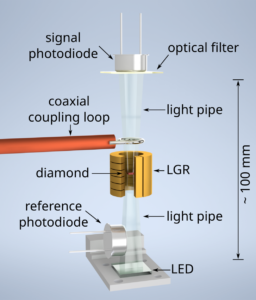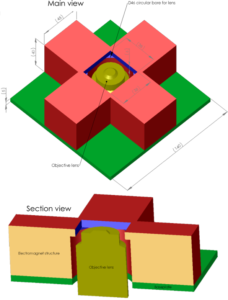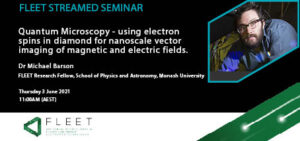
Kris Helmerson, FLEET Chief Investigator, Monash University
The Challenge

Our compact low-cost high-bandwidth optical vector magnetometer is based on nitrogen-vacancy (NV) centres in diamond
Navigation and communication in challenging environments (e.g. underground/underwater) requires new technology to offer capability comparable to above-ground options. Such capability would allow for underground mine automation, submarine communication and drone navigation.
Investigation into new magnetometer technology requires application of precision bias fields, often with other requirements such as optics, microwaves, etc. Making such magnetic delivery systems constrained and poorly performing.
The Solution
A magnetometer provides a solution for high-bandwidth communication in such challenging environments (e.g. through conductive media such as rain-water).
Using magnetic circuits can significantly boost the efficiency of a magnetic system. Our design uses three folded axes of magnetic circuits to provide XYZ vector magnetic fields.
Key Benefits
- Magnetometer Deployable, low-cost vector magnetometer suitable for navigation, magnetic communication and magnetic anomaly detection. Compact (L < 100 mm), low-cost (< $1k), high-bandwidth (DC – 5 MHz), and sensitive (< 100 pT/√Hz)
- Electromagnet Compact electromagnet with full vector control (10 mT per axis). Hemisphere of space is free to mount samples. Central hole (D46 mm) suitable for an objective lens. Higher field variants are possible.
Development Stage
-
Magnetometer
- TRL 3/4 – hand-held working prototype with off-the-shelf optics
- Future improvements include miniaturisation of control system and optimisation of performance
- Electromagnet
- Design finalised and available for purchase, some sales already made
- Future higher field variants still in design stages
Brief Description & Differentiation
Our optical magnetometer uses an ensemble of nitrogen-vacancy (NV) centres in diamond to measure the vector components of a magnetic field (Bx, By, Bz). It uses simple contact optics (light-pipes), an LED and photodiode. This results in a relatively cheap and very robust magnetometer with unusually high bandwidth and good sensitivity.
Our electromagnet’s use of three axes of magnetic circuits to generate magnetic field in three orthogonal directions results in a more-efficient electromagnet, achieving fields much stronger than more cumbersome three-axis Helmholtz coils, without sacrificing homogeneity or vector capability.
Intellectual Property
Electromagnet (WO2021226652A1)
Key Publications
- MSJ Barson, Nanoscale Vector Electric Field Imaging Using a Single Electron Spin, Nano Lett. 21 (2021)
More information
- Contact Dr Michael Barson, Monash University michael.barson@monash.edu
- Contact Prof Kris Helmerson, Monash University kristian.helmerson@monash.edu



